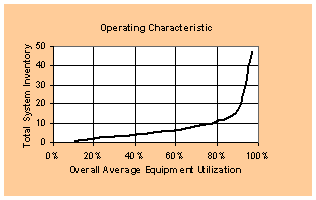|

The free newsletter of Lean Manufacturing Strategy
Lean Briefing Archives

Books & Videos

The Strategos Guide To Value Stream and Process Mapping goes far beyond symbols and arrows. In over 163 pages it tells the reader not only how to do it but what to do with it.
More info...
Strategos Guide to Value Stream & Process Mapping
Also...
Guide to Cycle Counting
Facilities & Workplace Design
Warehouse Planning Guide
Human Side of Lean Video


|
 |
Capacity, Inventory, Delivery & Variability
How High Capacity Utilization Degrades Delivery Performance
|
|
High capacity utilization increases inventory and
degrades delivery performance. This principle holds true for most practical manufacturing
situations. It has important implications for marketing, manufacturing, facility and financial
strategies.
The figure shows how inventory typically increases with
increasing utilization of factory equipment. At low utilization rates, inventory is present only
at workstations and the job is worked quickly. As utilization increases, queues form and
inventory builds. As average utilization approaches the practical maximum, inventory rises
quickly, theoretically to infinity.
|
 |
|
Little's Law states that average throughput time through a production system is directly
proportional to average inventory. Think of a tank of water with a constant inflow and a
constant, identical outflow.
In this analogy, the input spigot represents orders coming to the factory. The outlet
represents finished product. Water in the tank represents WIP inventory. Average throughput or
dwell time in the tank is 100 minutes. If we lower the level to 100 gallons and maintain the
same flow, throughput time is only 10 minutes.
|
 |
Delivery Performance
Delivery performance has at least two dimensions: speed
and reliability. Speed is how fast you deliver; reliability is how dependable your delivery
dates are. For a variety of reasons, speed and reliability are linked: fast deliveries are
usually more reliable.
Little's Law is the connection between capacity utilization and
delivery performance. As utilization increases, inventory increases, throughput time increases
and delivery performance declines. The chart shows this effect qualitatively.
While a finished goods inventory can compensate for excessive lead
time, it also creates a new set of problems.
|
 |
|
Variability causes this peculiar relationship between
capacity and inventory. It is inherent in most work processes. Variation in work time, routing,
quality and batching creates and exacerbates these effects. For more on this, see our upcoming
page on Manufacturing Variability.
|
The strategic implications in finance, marketing and manufacturing are
important and profound. For more on these specific implications,
click here.
|
|
|





